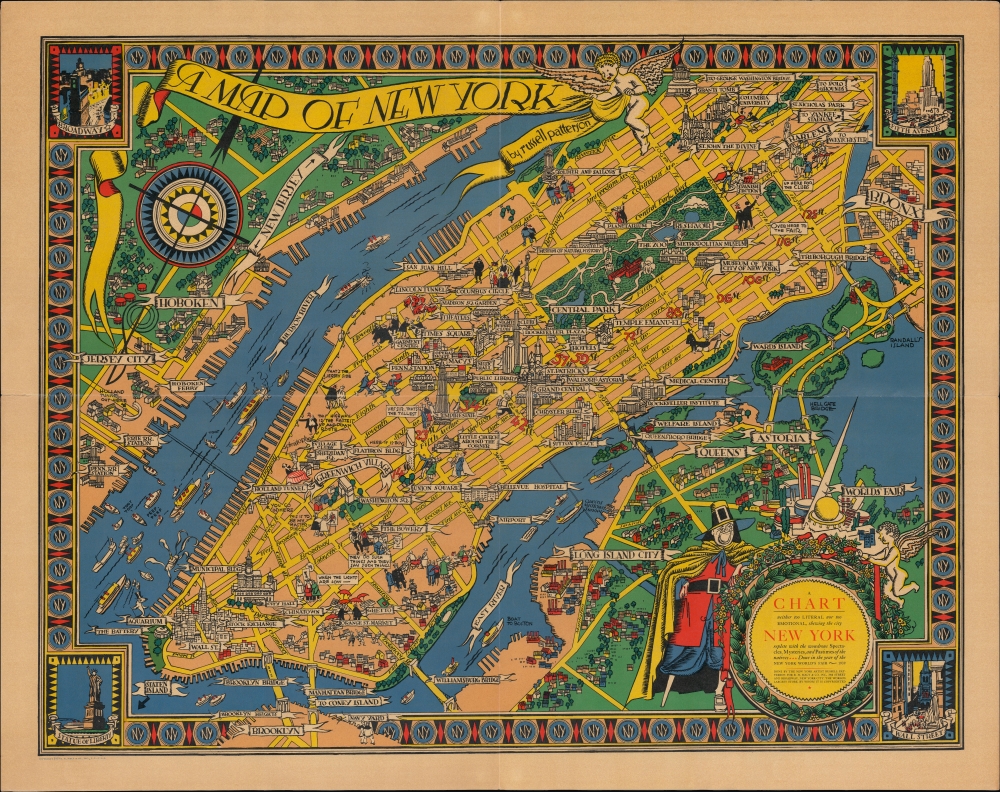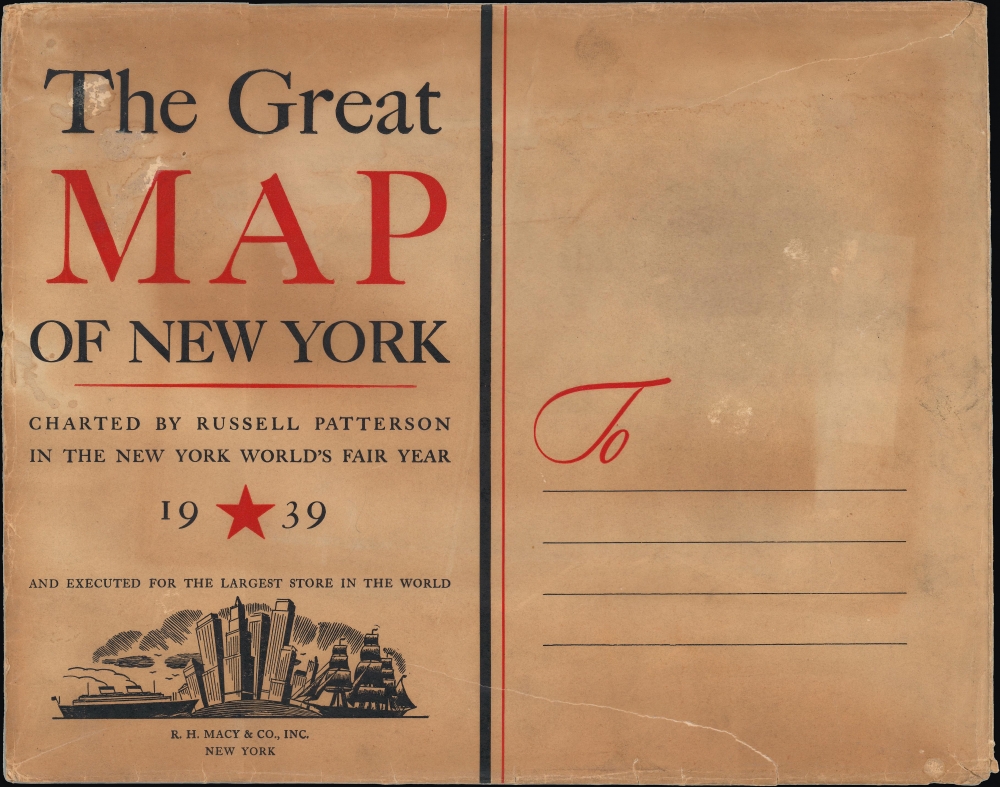1939 Patterson Pictorial View of New York City, World's Fair
NYCWorldsFair-patterson-1939
Title
1939 (dated) 20 x 25.75 in (50.8 x 65.405 cm)
Description
A Closer Look
Oriented towards the northwest, this bird's-eye view map covers much of Manhattan and portions of New Jersey, Brooklyn, Queens, and the Bronx. Major landmarks and famous buildings are labeled, including skyscrapers, museums, churches, hospitals, parks, and the city's new tunnels and bridges built in the preceding years (the Holland, Lincoln, and Queens Midtown Tunnels, as well as the Triborough Bridge and George Washington Bridge, referred to but beyond the scope of the view). Notably, at right is the site of the World's Fair in Flushing Meadows Corona Park. Several neighborhoods are also labeled, including names that later fell out of fashion, such as 'San Juan Hill' for the neighborhood around today's Lincoln Center and 'Ghetto' for the Lower East Side. Several references are made to clubs and nightlife, including a suggestive note near Chinatown: 'When the lights are low-'.Macy's on Herald Square, which commissioned the map, is labeled near center. Illustrated vignettes of Broadway, Fifth Avenue, Wall Street, and the Statue of Liberty appear in the corners, while the stylized border includes circles with the abbreviation 'NY' repeated. The curious title cartouche at bottom-right and title ribbon at top-left are reminiscent of early modern European maps. The smiling peg-legged figure is likely meant to be Peter Stuyvesant (c. 1610 - 1672), the domineering and influential Dutch director-general of New Netherland (including New Amsterdam) in its final years before being ceded to the English.
The 1939 - 1940 New York World's Fair
The 1939 - 1940 New York World's Fair took place in Queens at Flushing Meadows Corona Park, with the opening coinciding with the 150th anniversary of George Washington's inauguration. During its two exhibition seasons, over 44,000,000 people attended, making it one of the busiest World's Fairs of all time. It was also the second most expensive World's Fair in the United States, behind the 1904 Louisiana Purchase Exposition in St. Louis, Missouri. With a focus on the future, Art Deco and streamlined design dominated, from architecture to automobiles, sculpture, and interior design. Particularly memorable was General Motors' pavilion, designed by Norman Bel Geddes (1893 - 1958), titled 'Futurama,' which is credited with introducing the notion of a national network of automobile expressways to the American public.The government pavilions reflected the geopolitics of the era, with the Italian, German, Japanese, and Soviet governments spending lavishly to outdo each other in terms of grandiosity. Other nations tried to use the fair to attract attention and gain support in the United States, including Poland and a Jewish Palestine pavilion, one of the best attended of the entire fair. World War II (1939 - 1945) began four months after the fair opened, and many of the displays were affected, particularly those pavilions of countries under Axis occupation. After the fair closed in 1940, many of the European staff were unable to return home, so they stayed in the United States.
Publication History and Census
This pictorial view was drawn by Russell Patterson for the department store R.H. Macy and Co. ('the world's largest store') in 1939. It is rare, only being cataloged among the holdings of the University of Houston in the OCLC. It is also held by the David Rumsey Historical Map Collection.Cartographer
Russell Patterson (December 26, 1893 - March 17, 1977) was a cartoonist, illustrator, and designer whose Art Deco-inspired works featured prominently in magazines of the 1920s and 1930s, to the extent that he is credited with helping create the 'flapper' image. Patterson was born in Omaha, Nebraska but his family relocated to Montreal during his childhood. He briefly studied architecture at McGill University and began submitting cartoons to local newspapers. He then moved to Chicago, attended some classes at the Art Institute of Chicago, and began working as an interior designer for upscale department stores in the city. Patterson then attempted to sell a mail order course of art courses, carved out a niche as a humorous artist, and then briefly, unsuccessfully attempted to become a fine artist, traveling to the American Southwest. In 1925, Patterson moved to New York City and began drawing humorous illustrations for publications including College Humor, Judge, Life, Ballyhoo, Vogue, Vanity Fair, Cosmopolitan. His distinctive style became wildly popular, earning him wide acclaim and vaulting him from obscurity to fame in a matter of months. His works became archetypal, deeply influencing other artists, defining the image of the flapper girl of the 1920s, and even setting fashion standards. Patterson also continued to design department store interiors, including for R. H. Macy and Co. (Macy's). In the early 1930s, he began to work as a set designer on Broadway and then took on similar roles in Hollywood. Beginning in 1929, he also published comic strips in major Sunday newspapers, which became his main focus by the late 1930s and continuing into the mid-1950s. Patterson also dabbled in fashion, helping to design the uniforms of the Women's Army Auxiliary Corps during the Second World War. More by this mapmaker...




